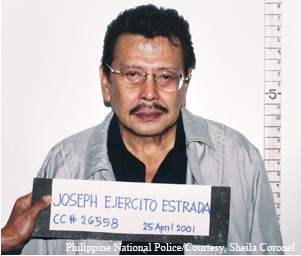Philippine Center for Investigative Journalism, 2000
About the Investigation

In 2000, the Philippine Center for Investigative Journalism (PCIJ) released a series of stories, the result of a year-long investigation into the unexplained wealth of then-Philippine President Joseph Estrada.
His undisclosed assets include several mansions and hidden stakes in more than a dozen companies. Using dogged research and voluminous public records, the team uncovered 17 pieces of real estate acquired by the President and various family members since his election in 1998, with a value of about US$40 million. They uncovered 66 companies in which Estrada, his wives and children were listed as incorporators or board members. “This case study shows that patient, steadfast investigative journalism can have an immense impact—even in a country rife with weak law enforcement, corruption and close-knit cronyism,” reads a World Bank report on the case.
Impact
 Due to Estrada’s popularity, the series had little impact at first. The PCIJ’s first report had little impact at first. The Center struggled to find media outlets willing to publish and report on it. The turning point came with a second report three months later later that garnered broader coverage. The PCIJ continued to release several more investigations in the subsequent months. Its reporting was carried by major newspapers as well as national radio and TV networks. “For us it was a breakthrough,” recalls then-PCIJ Executive Director Sheila Coronel.“The media environment became more receptive to investigative reporting on Estrada. The public, too, was hungry for information.”
Due to Estrada’s popularity, the series had little impact at first. The PCIJ’s first report had little impact at first. The Center struggled to find media outlets willing to publish and report on it. The turning point came with a second report three months later later that garnered broader coverage. The PCIJ continued to release several more investigations in the subsequent months. Its reporting was carried by major newspapers as well as national radio and TV networks. “For us it was a breakthrough,” recalls then-PCIJ Executive Director Sheila Coronel.“The media environment became more receptive to investigative reporting on Estrada. The public, too, was hungry for information.”
An impeachment charge against the president was introduced in the Philippine Congress, accusing Estrada of corruption and graft. The Lower House used three of the PCIJ’s reports as evidence. By now, Estrada’s hidden assets had become the biggest story in the Philippines. As the impeachment proceedings began, PCIJ published new revelations of the president’s corruption in a book, Investigating Estrada: Millions, Mansions and Mistresses. When it seemed the impeachment trial had stalled in the Philippine Senate, Filipinos took to the streets in protests that grew to half a million people. Days later, the Supreme Court ousted Estrada and the vice president took his place. On 2007, a Philippine court convicted Estrada and he was sentenced to a life term.
